Objective synopses Literature Review 2022
VerifiedAdded on 2022/10/06
|15
|4732
|19
AI Summary
Contribute Materials
Your contribution can guide someone’s learning journey. Share your
documents today.
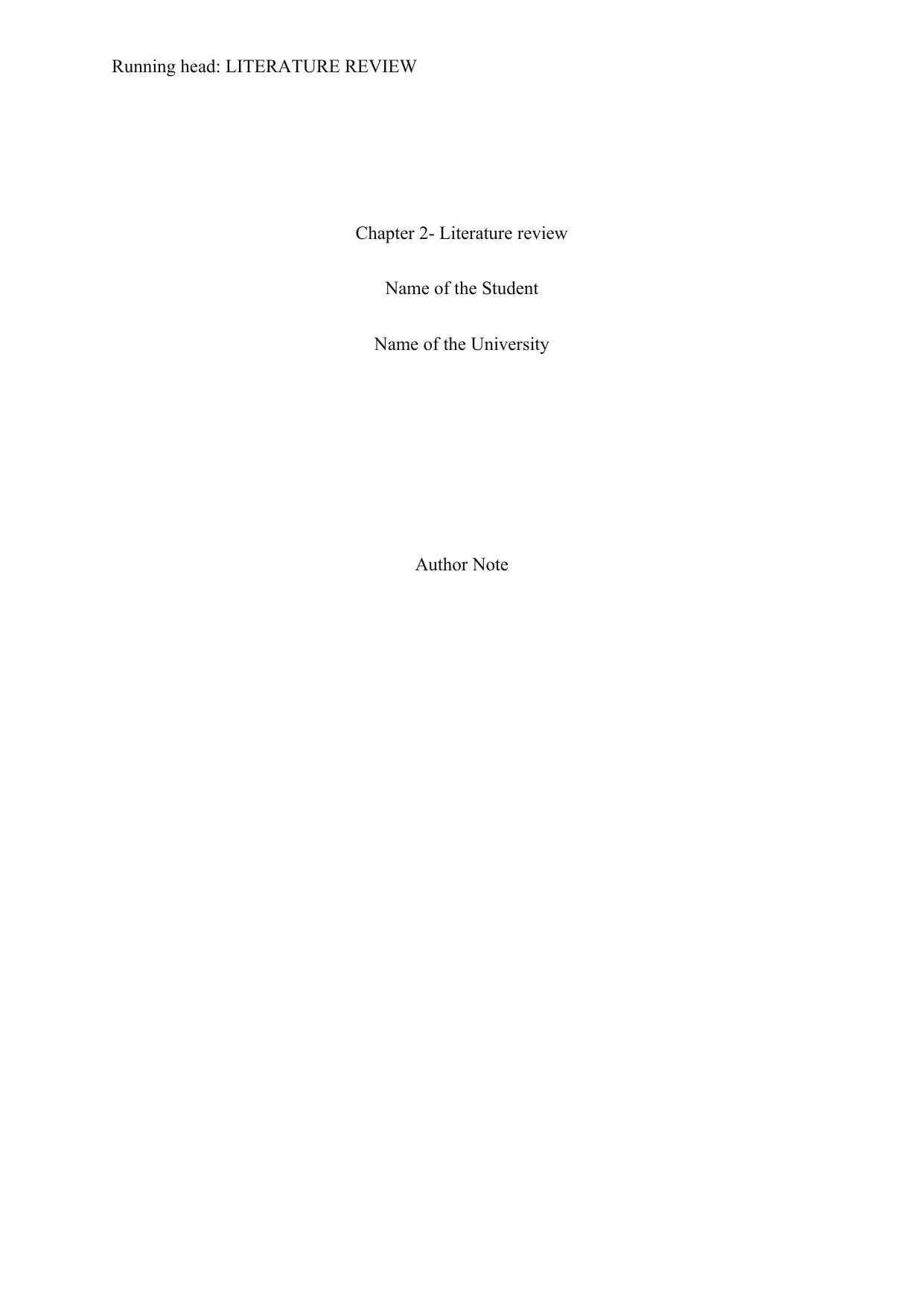
Running head: LITERATURE REVIEW
Chapter 2- Literature review
Name of the Student
Name of the University
Author Note
Chapter 2- Literature review
Name of the Student
Name of the University
Author Note
Secure Best Marks with AI Grader
Need help grading? Try our AI Grader for instant feedback on your assignments.
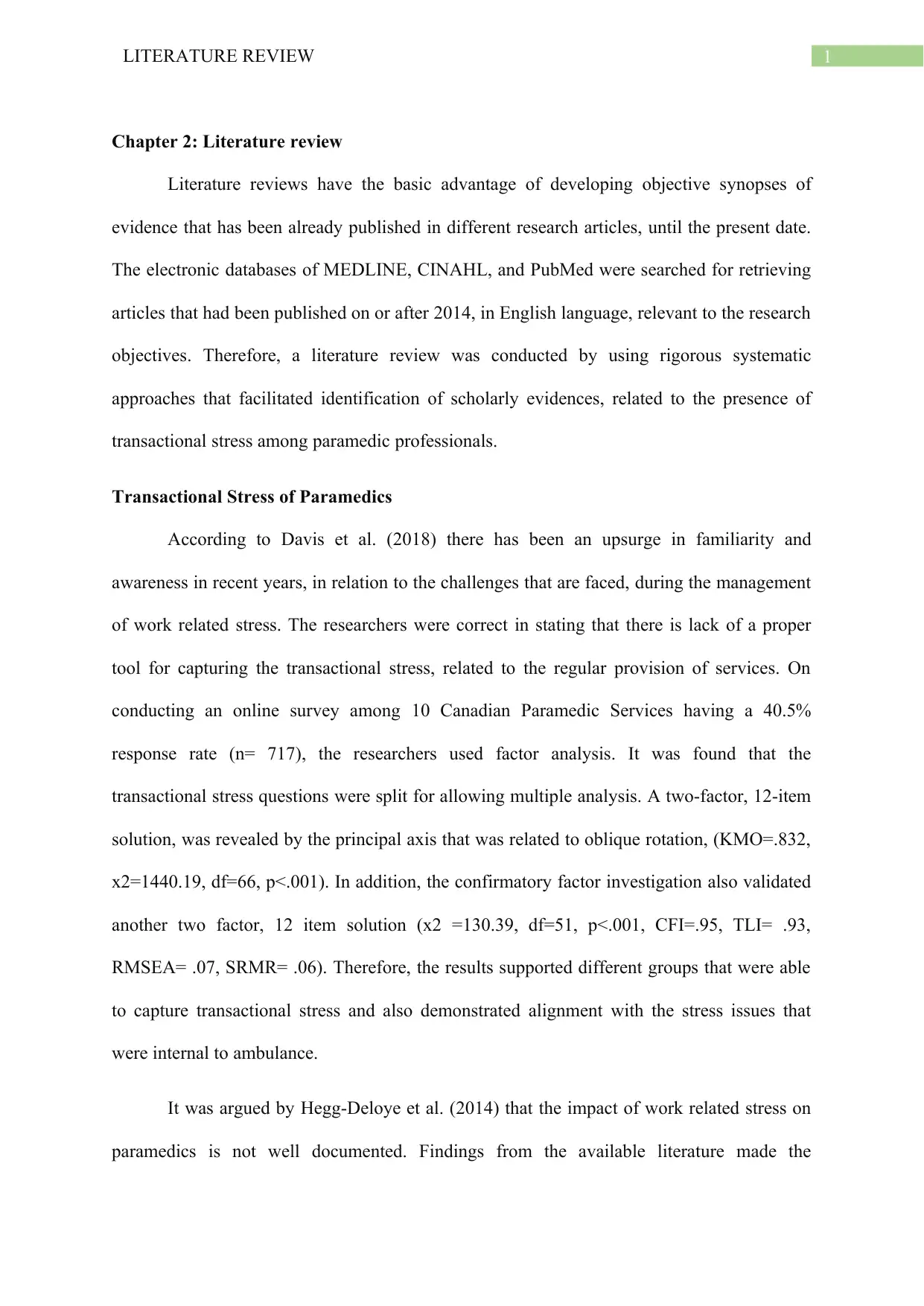
1LITERATURE REVIEW
Chapter 2: Literature review
Literature reviews have the basic advantage of developing objective synopses of
evidence that has been already published in different research articles, until the present date.
The electronic databases of MEDLINE, CINAHL, and PubMed were searched for retrieving
articles that had been published on or after 2014, in English language, relevant to the research
objectives. Therefore, a literature review was conducted by using rigorous systematic
approaches that facilitated identification of scholarly evidences, related to the presence of
transactional stress among paramedic professionals.
Transactional Stress of Paramedics
According to Davis et al. (2018) there has been an upsurge in familiarity and
awareness in recent years, in relation to the challenges that are faced, during the management
of work related stress. The researchers were correct in stating that there is lack of a proper
tool for capturing the transactional stress, related to the regular provision of services. On
conducting an online survey among 10 Canadian Paramedic Services having a 40.5%
response rate (n= 717), the researchers used factor analysis. It was found that the
transactional stress questions were split for allowing multiple analysis. A two-factor, 12-item
solution, was revealed by the principal axis that was related to oblique rotation, (KMO=.832,
x2=1440.19, df=66, p<.001). In addition, the confirmatory factor investigation also validated
another two factor, 12 item solution (x2 =130.39, df=51, p<.001, CFI=.95, TLI= .93,
RMSEA= .07, SRMR= .06). Therefore, the results supported different groups that were able
to capture transactional stress and also demonstrated alignment with the stress issues that
were internal to ambulance.
It was argued by Hegg-Deloye et al. (2014) that the impact of work related stress on
paramedics is not well documented. Findings from the available literature made the
Chapter 2: Literature review
Literature reviews have the basic advantage of developing objective synopses of
evidence that has been already published in different research articles, until the present date.
The electronic databases of MEDLINE, CINAHL, and PubMed were searched for retrieving
articles that had been published on or after 2014, in English language, relevant to the research
objectives. Therefore, a literature review was conducted by using rigorous systematic
approaches that facilitated identification of scholarly evidences, related to the presence of
transactional stress among paramedic professionals.
Transactional Stress of Paramedics
According to Davis et al. (2018) there has been an upsurge in familiarity and
awareness in recent years, in relation to the challenges that are faced, during the management
of work related stress. The researchers were correct in stating that there is lack of a proper
tool for capturing the transactional stress, related to the regular provision of services. On
conducting an online survey among 10 Canadian Paramedic Services having a 40.5%
response rate (n= 717), the researchers used factor analysis. It was found that the
transactional stress questions were split for allowing multiple analysis. A two-factor, 12-item
solution, was revealed by the principal axis that was related to oblique rotation, (KMO=.832,
x2=1440.19, df=66, p<.001). In addition, the confirmatory factor investigation also validated
another two factor, 12 item solution (x2 =130.39, df=51, p<.001, CFI=.95, TLI= .93,
RMSEA= .07, SRMR= .06). Therefore, the results supported different groups that were able
to capture transactional stress and also demonstrated alignment with the stress issues that
were internal to ambulance.
It was argued by Hegg-Deloye et al. (2014) that the impact of work related stress on
paramedics is not well documented. Findings from the available literature made the
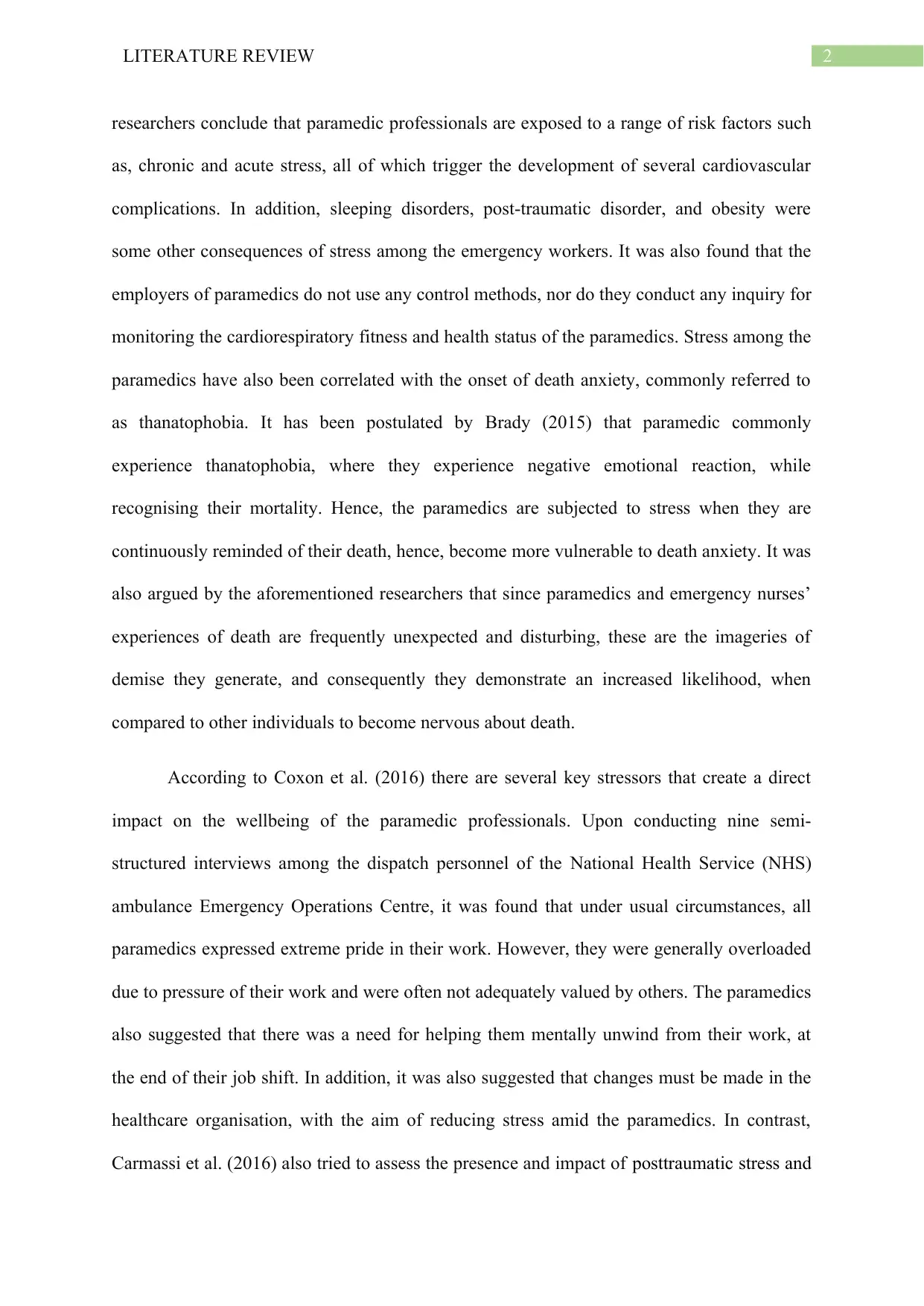
2LITERATURE REVIEW
researchers conclude that paramedic professionals are exposed to a range of risk factors such
as, chronic and acute stress, all of which trigger the development of several cardiovascular
complications. In addition, sleeping disorders, post-traumatic disorder, and obesity were
some other consequences of stress among the emergency workers. It was also found that the
employers of paramedics do not use any control methods, nor do they conduct any inquiry for
monitoring the cardiorespiratory fitness and health status of the paramedics. Stress among the
paramedics have also been correlated with the onset of death anxiety, commonly referred to
as thanatophobia. It has been postulated by Brady (2015) that paramedic commonly
experience thanatophobia, where they experience negative emotional reaction, while
recognising their mortality. Hence, the paramedics are subjected to stress when they are
continuously reminded of their death, hence, become more vulnerable to death anxiety. It was
also argued by the aforementioned researchers that since paramedics and emergency nurses’
experiences of death are frequently unexpected and disturbing, these are the imageries of
demise they generate, and consequently they demonstrate an increased likelihood, when
compared to other individuals to become nervous about death.
According to Coxon et al. (2016) there are several key stressors that create a direct
impact on the wellbeing of the paramedic professionals. Upon conducting nine semi-
structured interviews among the dispatch personnel of the National Health Service (NHS)
ambulance Emergency Operations Centre, it was found that under usual circumstances, all
paramedics expressed extreme pride in their work. However, they were generally overloaded
due to pressure of their work and were often not adequately valued by others. The paramedics
also suggested that there was a need for helping them mentally unwind from their work, at
the end of their job shift. In addition, it was also suggested that changes must be made in the
healthcare organisation, with the aim of reducing stress amid the paramedics. In contrast,
Carmassi et al. (2016) also tried to assess the presence and impact of posttraumatic stress and
researchers conclude that paramedic professionals are exposed to a range of risk factors such
as, chronic and acute stress, all of which trigger the development of several cardiovascular
complications. In addition, sleeping disorders, post-traumatic disorder, and obesity were
some other consequences of stress among the emergency workers. It was also found that the
employers of paramedics do not use any control methods, nor do they conduct any inquiry for
monitoring the cardiorespiratory fitness and health status of the paramedics. Stress among the
paramedics have also been correlated with the onset of death anxiety, commonly referred to
as thanatophobia. It has been postulated by Brady (2015) that paramedic commonly
experience thanatophobia, where they experience negative emotional reaction, while
recognising their mortality. Hence, the paramedics are subjected to stress when they are
continuously reminded of their death, hence, become more vulnerable to death anxiety. It was
also argued by the aforementioned researchers that since paramedics and emergency nurses’
experiences of death are frequently unexpected and disturbing, these are the imageries of
demise they generate, and consequently they demonstrate an increased likelihood, when
compared to other individuals to become nervous about death.
According to Coxon et al. (2016) there are several key stressors that create a direct
impact on the wellbeing of the paramedic professionals. Upon conducting nine semi-
structured interviews among the dispatch personnel of the National Health Service (NHS)
ambulance Emergency Operations Centre, it was found that under usual circumstances, all
paramedics expressed extreme pride in their work. However, they were generally overloaded
due to pressure of their work and were often not adequately valued by others. The paramedics
also suggested that there was a need for helping them mentally unwind from their work, at
the end of their job shift. In addition, it was also suggested that changes must be made in the
healthcare organisation, with the aim of reducing stress amid the paramedics. In contrast,
Carmassi et al. (2016) also tried to assess the presence and impact of posttraumatic stress and
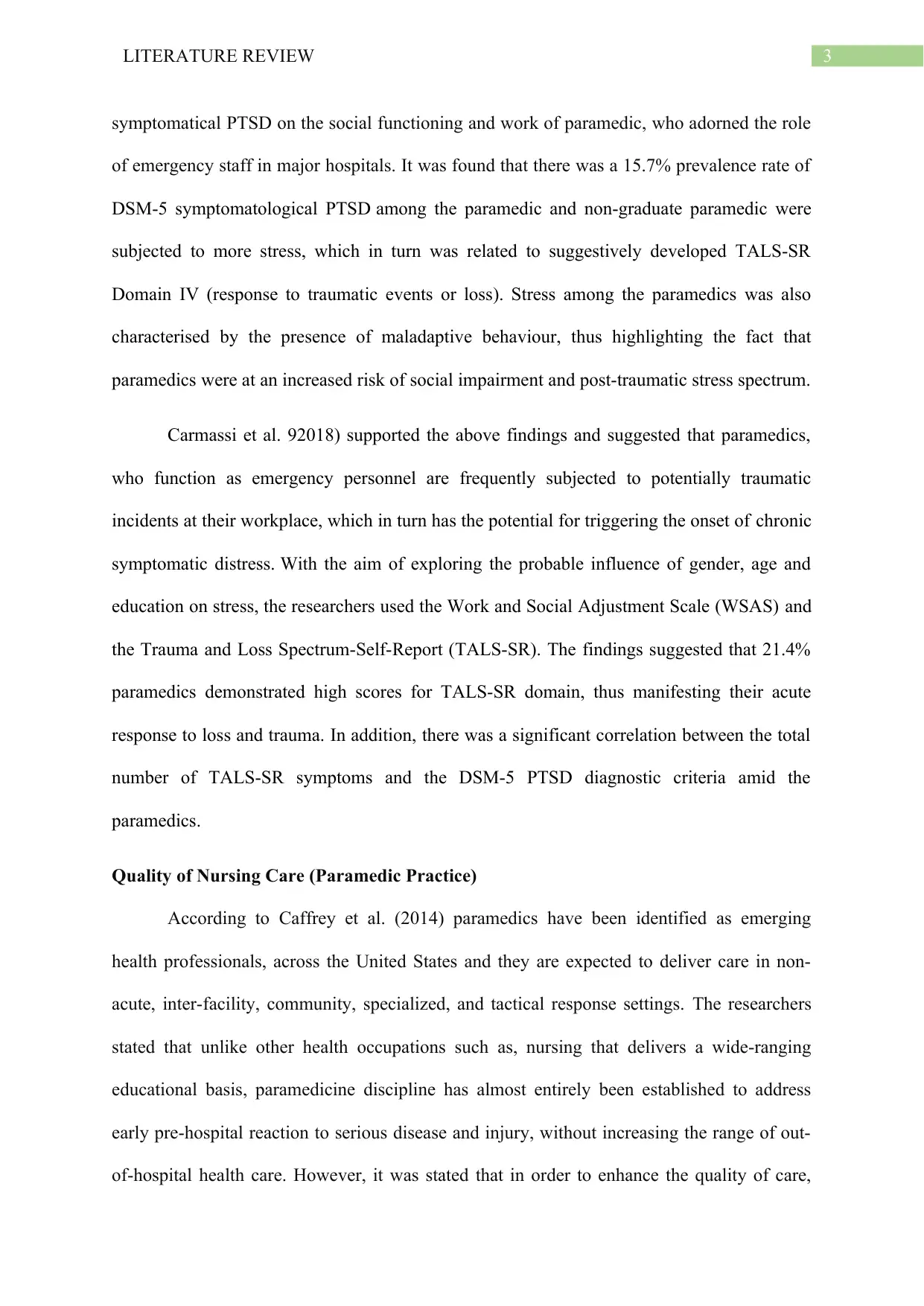
3LITERATURE REVIEW
symptomatical PTSD on the social functioning and work of paramedic, who adorned the role
of emergency staff in major hospitals. It was found that there was a 15.7% prevalence rate of
DSM-5 symptomatological PTSD among the paramedic and non-graduate paramedic were
subjected to more stress, which in turn was related to suggestively developed TALS-SR
Domain IV (response to traumatic events or loss). Stress among the paramedics was also
characterised by the presence of maladaptive behaviour, thus highlighting the fact that
paramedics were at an increased risk of social impairment and post-traumatic stress spectrum.
Carmassi et al. 92018) supported the above findings and suggested that paramedics,
who function as emergency personnel are frequently subjected to potentially traumatic
incidents at their workplace, which in turn has the potential for triggering the onset of chronic
symptomatic distress. With the aim of exploring the probable influence of gender, age and
education on stress, the researchers used the Work and Social Adjustment Scale (WSAS) and
the Trauma and Loss Spectrum-Self-Report (TALS-SR). The findings suggested that 21.4%
paramedics demonstrated high scores for TALS-SR domain, thus manifesting their acute
response to loss and trauma. In addition, there was a significant correlation between the total
number of TALS-SR symptoms and the DSM-5 PTSD diagnostic criteria amid the
paramedics.
Quality of Nursing Care (Paramedic Practice)
According to Caffrey et al. (2014) paramedics have been identified as emerging
health professionals, across the United States and they are expected to deliver care in non-
acute, inter-facility, community, specialized, and tactical response settings. The researchers
stated that unlike other health occupations such as, nursing that delivers a wide-ranging
educational basis, paramedicine discipline has almost entirely been established to address
early pre-hospital reaction to serious disease and injury, without increasing the range of out-
of-hospital health care. However, it was stated that in order to enhance the quality of care,
symptomatical PTSD on the social functioning and work of paramedic, who adorned the role
of emergency staff in major hospitals. It was found that there was a 15.7% prevalence rate of
DSM-5 symptomatological PTSD among the paramedic and non-graduate paramedic were
subjected to more stress, which in turn was related to suggestively developed TALS-SR
Domain IV (response to traumatic events or loss). Stress among the paramedics was also
characterised by the presence of maladaptive behaviour, thus highlighting the fact that
paramedics were at an increased risk of social impairment and post-traumatic stress spectrum.
Carmassi et al. 92018) supported the above findings and suggested that paramedics,
who function as emergency personnel are frequently subjected to potentially traumatic
incidents at their workplace, which in turn has the potential for triggering the onset of chronic
symptomatic distress. With the aim of exploring the probable influence of gender, age and
education on stress, the researchers used the Work and Social Adjustment Scale (WSAS) and
the Trauma and Loss Spectrum-Self-Report (TALS-SR). The findings suggested that 21.4%
paramedics demonstrated high scores for TALS-SR domain, thus manifesting their acute
response to loss and trauma. In addition, there was a significant correlation between the total
number of TALS-SR symptoms and the DSM-5 PTSD diagnostic criteria amid the
paramedics.
Quality of Nursing Care (Paramedic Practice)
According to Caffrey et al. (2014) paramedics have been identified as emerging
health professionals, across the United States and they are expected to deliver care in non-
acute, inter-facility, community, specialized, and tactical response settings. The researchers
stated that unlike other health occupations such as, nursing that delivers a wide-ranging
educational basis, paramedicine discipline has almost entirely been established to address
early pre-hospital reaction to serious disease and injury, without increasing the range of out-
of-hospital health care. However, it was stated that in order to enhance the quality of care,
Secure Best Marks with AI Grader
Need help grading? Try our AI Grader for instant feedback on your assignments.
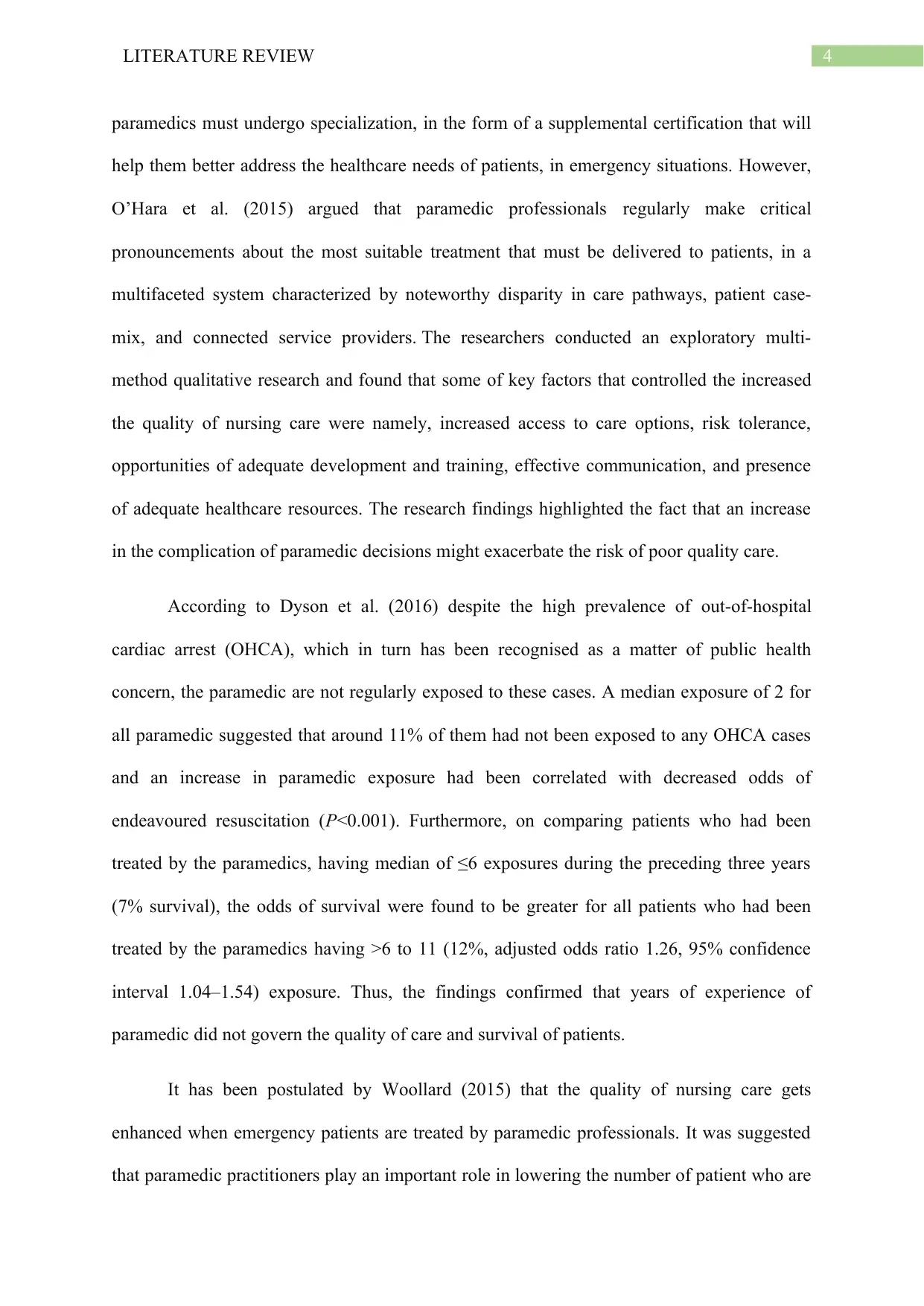
4LITERATURE REVIEW
paramedics must undergo specialization, in the form of a supplemental certification that will
help them better address the healthcare needs of patients, in emergency situations. However,
O’Hara et al. (2015) argued that paramedic professionals regularly make critical
pronouncements about the most suitable treatment that must be delivered to patients, in a
multifaceted system characterized by noteworthy disparity in care pathways, patient case-
mix, and connected service providers. The researchers conducted an exploratory multi-
method qualitative research and found that some of key factors that controlled the increased
the quality of nursing care were namely, increased access to care options, risk tolerance,
opportunities of adequate development and training, effective communication, and presence
of adequate healthcare resources. The research findings highlighted the fact that an increase
in the complication of paramedic decisions might exacerbate the risk of poor quality care.
According to Dyson et al. (2016) despite the high prevalence of out-of-hospital
cardiac arrest (OHCA), which in turn has been recognised as a matter of public health
concern, the paramedic are not regularly exposed to these cases. A median exposure of 2 for
all paramedic suggested that around 11% of them had not been exposed to any OHCA cases
and an increase in paramedic exposure had been correlated with decreased odds of
endeavoured resuscitation (P<0.001). Furthermore, on comparing patients who had been
treated by the paramedics, having median of ≤6 exposures during the preceding three years
(7% survival), the odds of survival were found to be greater for all patients who had been
treated by the paramedics having >6 to 11 (12%, adjusted odds ratio 1.26, 95% confidence
interval 1.04–1.54) exposure. Thus, the findings confirmed that years of experience of
paramedic did not govern the quality of care and survival of patients.
It has been postulated by Woollard (2015) that the quality of nursing care gets
enhanced when emergency patients are treated by paramedic professionals. It was suggested
that paramedic practitioners play an important role in lowering the number of patient who are
paramedics must undergo specialization, in the form of a supplemental certification that will
help them better address the healthcare needs of patients, in emergency situations. However,
O’Hara et al. (2015) argued that paramedic professionals regularly make critical
pronouncements about the most suitable treatment that must be delivered to patients, in a
multifaceted system characterized by noteworthy disparity in care pathways, patient case-
mix, and connected service providers. The researchers conducted an exploratory multi-
method qualitative research and found that some of key factors that controlled the increased
the quality of nursing care were namely, increased access to care options, risk tolerance,
opportunities of adequate development and training, effective communication, and presence
of adequate healthcare resources. The research findings highlighted the fact that an increase
in the complication of paramedic decisions might exacerbate the risk of poor quality care.
According to Dyson et al. (2016) despite the high prevalence of out-of-hospital
cardiac arrest (OHCA), which in turn has been recognised as a matter of public health
concern, the paramedic are not regularly exposed to these cases. A median exposure of 2 for
all paramedic suggested that around 11% of them had not been exposed to any OHCA cases
and an increase in paramedic exposure had been correlated with decreased odds of
endeavoured resuscitation (P<0.001). Furthermore, on comparing patients who had been
treated by the paramedics, having median of ≤6 exposures during the preceding three years
(7% survival), the odds of survival were found to be greater for all patients who had been
treated by the paramedics having >6 to 11 (12%, adjusted odds ratio 1.26, 95% confidence
interval 1.04–1.54) exposure. Thus, the findings confirmed that years of experience of
paramedic did not govern the quality of care and survival of patients.
It has been postulated by Woollard (2015) that the quality of nursing care gets
enhanced when emergency patients are treated by paramedic professionals. It was suggested
that paramedic practitioners play an important role in lowering the number of patient who are
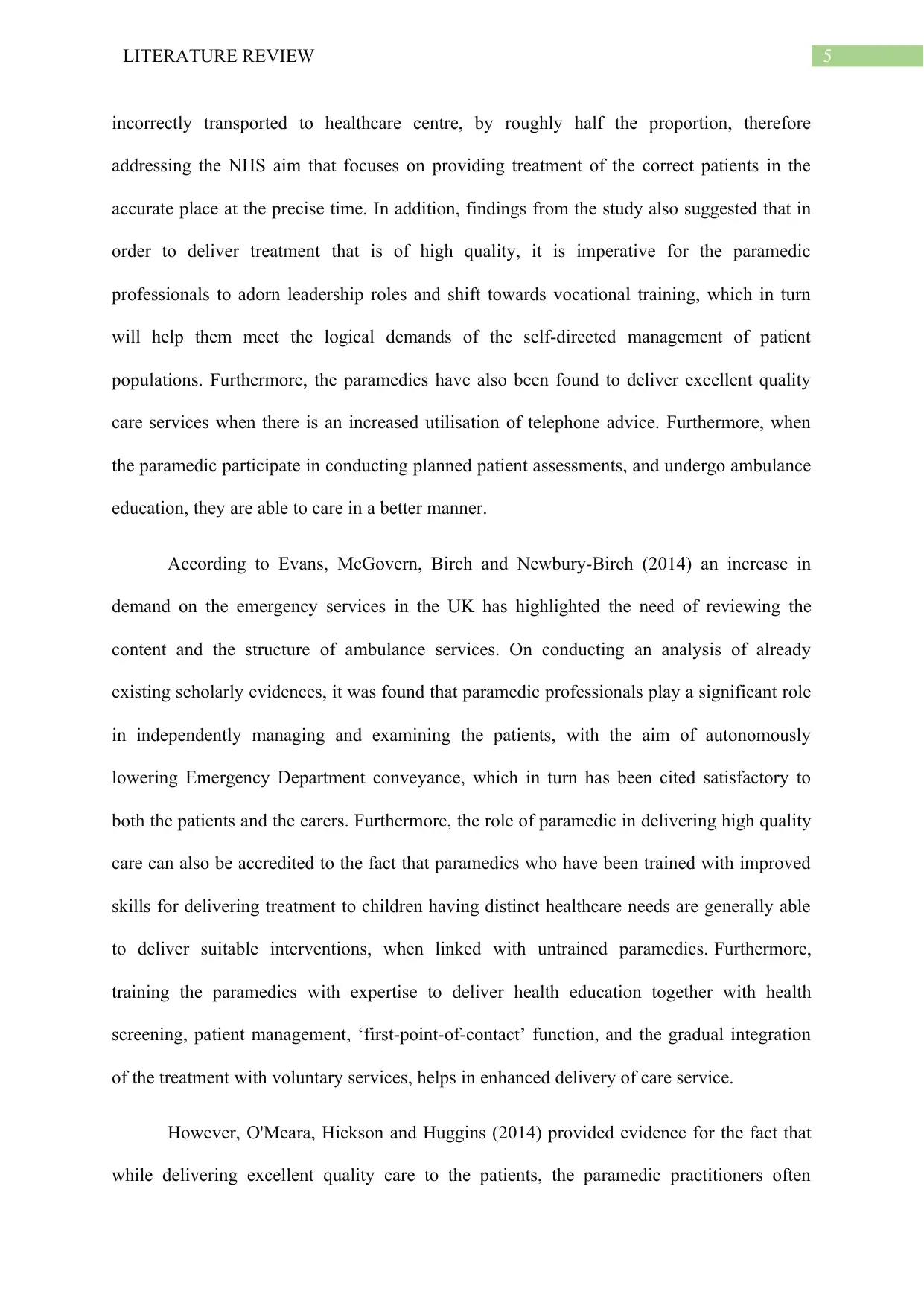
5LITERATURE REVIEW
incorrectly transported to healthcare centre, by roughly half the proportion, therefore
addressing the NHS aim that focuses on providing treatment of the correct patients in the
accurate place at the precise time. In addition, findings from the study also suggested that in
order to deliver treatment that is of high quality, it is imperative for the paramedic
professionals to adorn leadership roles and shift towards vocational training, which in turn
will help them meet the logical demands of the self-directed management of patient
populations. Furthermore, the paramedics have also been found to deliver excellent quality
care services when there is an increased utilisation of telephone advice. Furthermore, when
the paramedic participate in conducting planned patient assessments, and undergo ambulance
education, they are able to care in a better manner.
According to Evans, McGovern, Birch and Newbury-Birch (2014) an increase in
demand on the emergency services in the UK has highlighted the need of reviewing the
content and the structure of ambulance services. On conducting an analysis of already
existing scholarly evidences, it was found that paramedic professionals play a significant role
in independently managing and examining the patients, with the aim of autonomously
lowering Emergency Department conveyance, which in turn has been cited satisfactory to
both the patients and the carers. Furthermore, the role of paramedic in delivering high quality
care can also be accredited to the fact that paramedics who have been trained with improved
skills for delivering treatment to children having distinct healthcare needs are generally able
to deliver suitable interventions, when linked with untrained paramedics. Furthermore,
training the paramedics with expertise to deliver health education together with health
screening, patient management, ‘first-point-of-contact’ function, and the gradual integration
of the treatment with voluntary services, helps in enhanced delivery of care service.
However, O'Meara, Hickson and Huggins (2014) provided evidence for the fact that
while delivering excellent quality care to the patients, the paramedic practitioners often
incorrectly transported to healthcare centre, by roughly half the proportion, therefore
addressing the NHS aim that focuses on providing treatment of the correct patients in the
accurate place at the precise time. In addition, findings from the study also suggested that in
order to deliver treatment that is of high quality, it is imperative for the paramedic
professionals to adorn leadership roles and shift towards vocational training, which in turn
will help them meet the logical demands of the self-directed management of patient
populations. Furthermore, the paramedics have also been found to deliver excellent quality
care services when there is an increased utilisation of telephone advice. Furthermore, when
the paramedic participate in conducting planned patient assessments, and undergo ambulance
education, they are able to care in a better manner.
According to Evans, McGovern, Birch and Newbury-Birch (2014) an increase in
demand on the emergency services in the UK has highlighted the need of reviewing the
content and the structure of ambulance services. On conducting an analysis of already
existing scholarly evidences, it was found that paramedic professionals play a significant role
in independently managing and examining the patients, with the aim of autonomously
lowering Emergency Department conveyance, which in turn has been cited satisfactory to
both the patients and the carers. Furthermore, the role of paramedic in delivering high quality
care can also be accredited to the fact that paramedics who have been trained with improved
skills for delivering treatment to children having distinct healthcare needs are generally able
to deliver suitable interventions, when linked with untrained paramedics. Furthermore,
training the paramedics with expertise to deliver health education together with health
screening, patient management, ‘first-point-of-contact’ function, and the gradual integration
of the treatment with voluntary services, helps in enhanced delivery of care service.
However, O'Meara, Hickson and Huggins (2014) provided evidence for the fact that
while delivering excellent quality care to the patients, the paramedic practitioners often
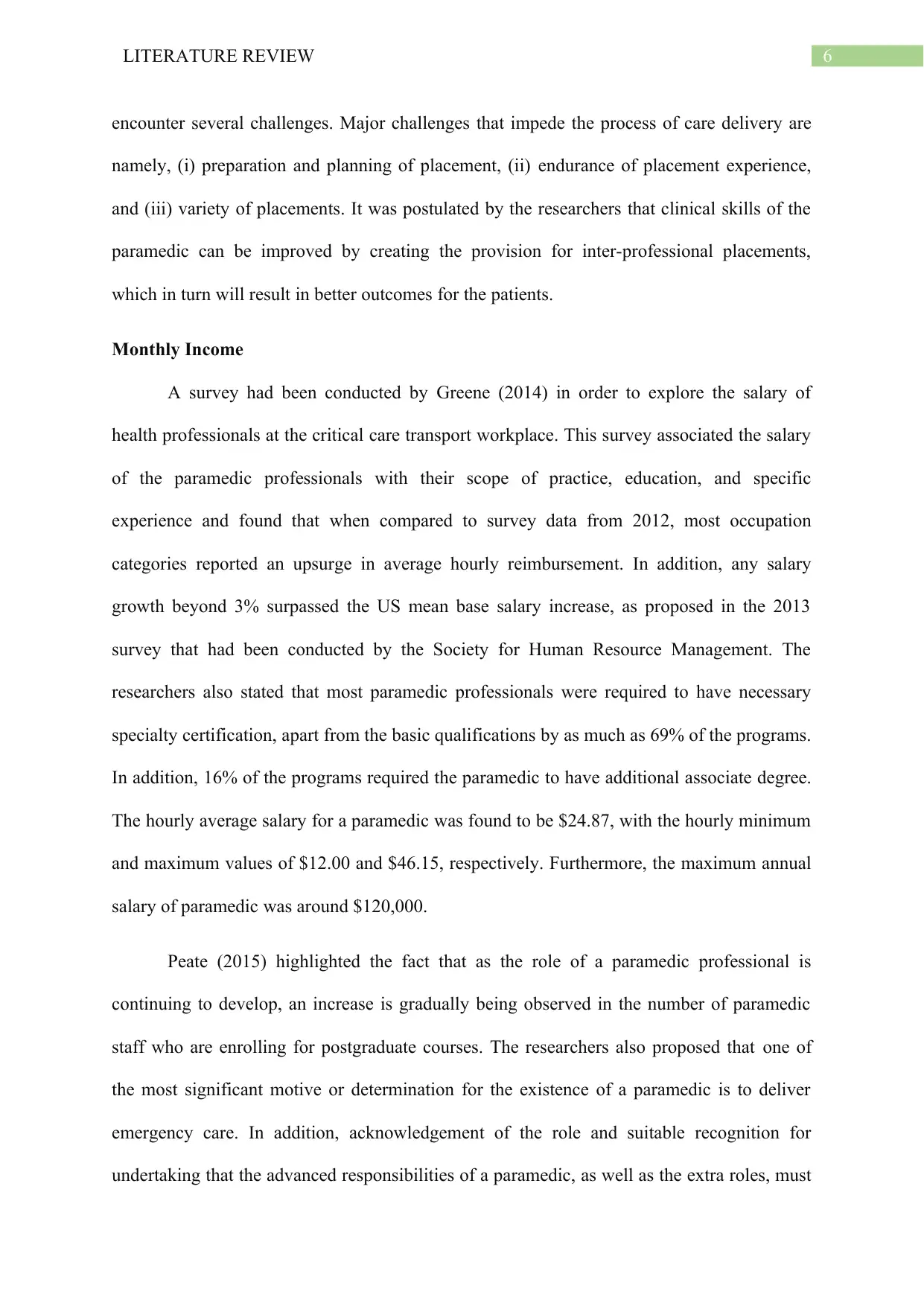
6LITERATURE REVIEW
encounter several challenges. Major challenges that impede the process of care delivery are
namely, (i) preparation and planning of placement, (ii) endurance of placement experience,
and (iii) variety of placements. It was postulated by the researchers that clinical skills of the
paramedic can be improved by creating the provision for inter-professional placements,
which in turn will result in better outcomes for the patients.
Monthly Income
A survey had been conducted by Greene (2014) in order to explore the salary of
health professionals at the critical care transport workplace. This survey associated the salary
of the paramedic professionals with their scope of practice, education, and specific
experience and found that when compared to survey data from 2012, most occupation
categories reported an upsurge in average hourly reimbursement. In addition, any salary
growth beyond 3% surpassed the US mean base salary increase, as proposed in the 2013
survey that had been conducted by the Society for Human Resource Management. The
researchers also stated that most paramedic professionals were required to have necessary
specialty certification, apart from the basic qualifications by as much as 69% of the programs.
In addition, 16% of the programs required the paramedic to have additional associate degree.
The hourly average salary for a paramedic was found to be $24.87, with the hourly minimum
and maximum values of $12.00 and $46.15, respectively. Furthermore, the maximum annual
salary of paramedic was around $120,000.
Peate (2015) highlighted the fact that as the role of a paramedic professional is
continuing to develop, an increase is gradually being observed in the number of paramedic
staff who are enrolling for postgraduate courses. The researchers also proposed that one of
the most significant motive or determination for the existence of a paramedic is to deliver
emergency care. In addition, acknowledgement of the role and suitable recognition for
undertaking that the advanced responsibilities of a paramedic, as well as the extra roles, must
encounter several challenges. Major challenges that impede the process of care delivery are
namely, (i) preparation and planning of placement, (ii) endurance of placement experience,
and (iii) variety of placements. It was postulated by the researchers that clinical skills of the
paramedic can be improved by creating the provision for inter-professional placements,
which in turn will result in better outcomes for the patients.
Monthly Income
A survey had been conducted by Greene (2014) in order to explore the salary of
health professionals at the critical care transport workplace. This survey associated the salary
of the paramedic professionals with their scope of practice, education, and specific
experience and found that when compared to survey data from 2012, most occupation
categories reported an upsurge in average hourly reimbursement. In addition, any salary
growth beyond 3% surpassed the US mean base salary increase, as proposed in the 2013
survey that had been conducted by the Society for Human Resource Management. The
researchers also stated that most paramedic professionals were required to have necessary
specialty certification, apart from the basic qualifications by as much as 69% of the programs.
In addition, 16% of the programs required the paramedic to have additional associate degree.
The hourly average salary for a paramedic was found to be $24.87, with the hourly minimum
and maximum values of $12.00 and $46.15, respectively. Furthermore, the maximum annual
salary of paramedic was around $120,000.
Peate (2015) highlighted the fact that as the role of a paramedic professional is
continuing to develop, an increase is gradually being observed in the number of paramedic
staff who are enrolling for postgraduate courses. The researchers also proposed that one of
the most significant motive or determination for the existence of a paramedic is to deliver
emergency care. In addition, acknowledgement of the role and suitable recognition for
undertaking that the advanced responsibilities of a paramedic, as well as the extra roles, must
Paraphrase This Document
Need a fresh take? Get an instant paraphrase of this document with our AI Paraphraser
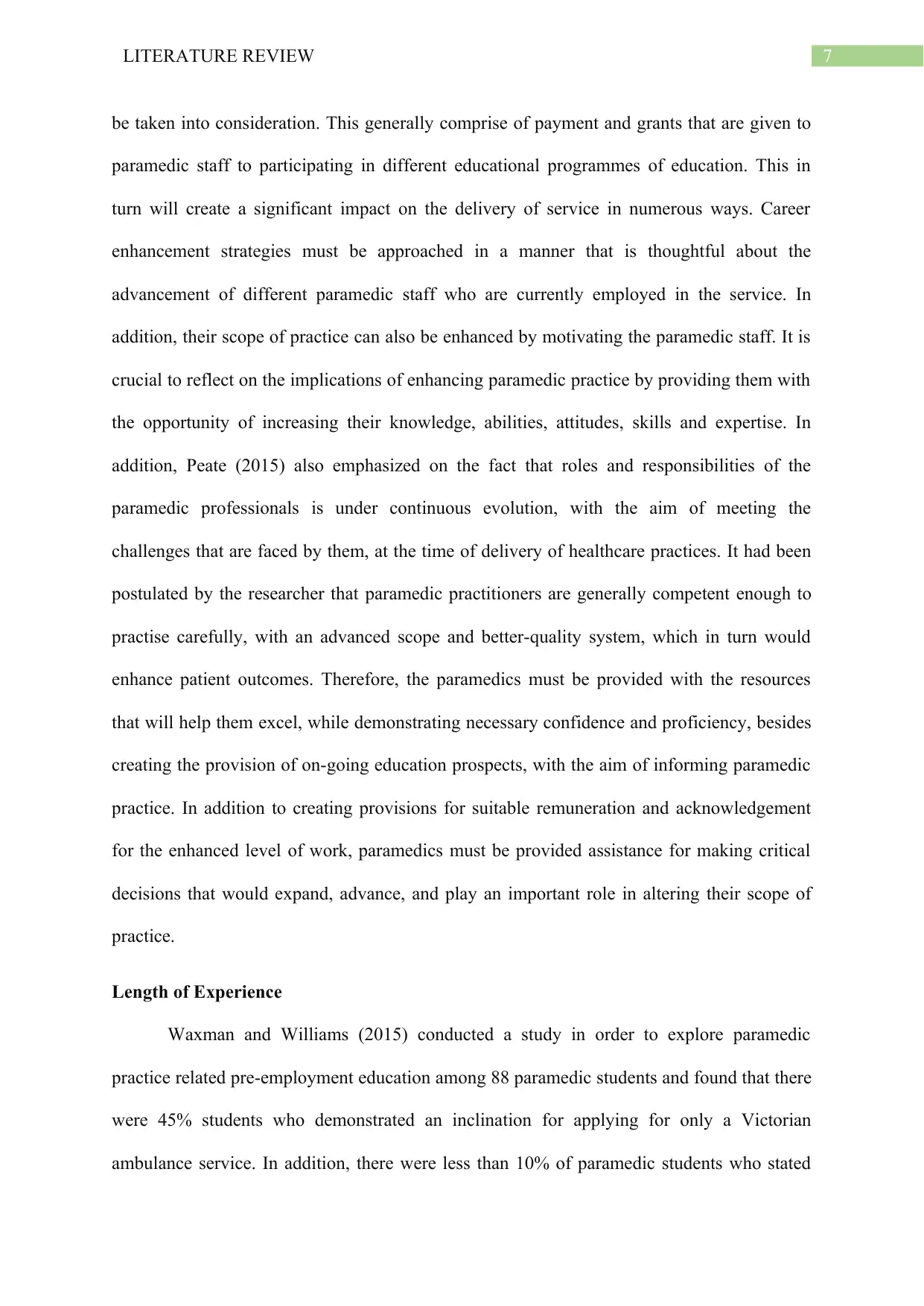
7LITERATURE REVIEW
be taken into consideration. This generally comprise of payment and grants that are given to
paramedic staff to participating in different educational programmes of education. This in
turn will create a significant impact on the delivery of service in numerous ways. Career
enhancement strategies must be approached in a manner that is thoughtful about the
advancement of different paramedic staff who are currently employed in the service. In
addition, their scope of practice can also be enhanced by motivating the paramedic staff. It is
crucial to reflect on the implications of enhancing paramedic practice by providing them with
the opportunity of increasing their knowledge, abilities, attitudes, skills and expertise. In
addition, Peate (2015) also emphasized on the fact that roles and responsibilities of the
paramedic professionals is under continuous evolution, with the aim of meeting the
challenges that are faced by them, at the time of delivery of healthcare practices. It had been
postulated by the researcher that paramedic practitioners are generally competent enough to
practise carefully, with an advanced scope and better-quality system, which in turn would
enhance patient outcomes. Therefore, the paramedics must be provided with the resources
that will help them excel, while demonstrating necessary confidence and proficiency, besides
creating the provision of on-going education prospects, with the aim of informing paramedic
practice. In addition to creating provisions for suitable remuneration and acknowledgement
for the enhanced level of work, paramedics must be provided assistance for making critical
decisions that would expand, advance, and play an important role in altering their scope of
practice.
Length of Experience
Waxman and Williams (2015) conducted a study in order to explore paramedic
practice related pre-employment education among 88 paramedic students and found that there
were 45% students who demonstrated an inclination for applying for only a Victorian
ambulance service. In addition, there were less than 10% of paramedic students who stated
be taken into consideration. This generally comprise of payment and grants that are given to
paramedic staff to participating in different educational programmes of education. This in
turn will create a significant impact on the delivery of service in numerous ways. Career
enhancement strategies must be approached in a manner that is thoughtful about the
advancement of different paramedic staff who are currently employed in the service. In
addition, their scope of practice can also be enhanced by motivating the paramedic staff. It is
crucial to reflect on the implications of enhancing paramedic practice by providing them with
the opportunity of increasing their knowledge, abilities, attitudes, skills and expertise. In
addition, Peate (2015) also emphasized on the fact that roles and responsibilities of the
paramedic professionals is under continuous evolution, with the aim of meeting the
challenges that are faced by them, at the time of delivery of healthcare practices. It had been
postulated by the researcher that paramedic practitioners are generally competent enough to
practise carefully, with an advanced scope and better-quality system, which in turn would
enhance patient outcomes. Therefore, the paramedics must be provided with the resources
that will help them excel, while demonstrating necessary confidence and proficiency, besides
creating the provision of on-going education prospects, with the aim of informing paramedic
practice. In addition to creating provisions for suitable remuneration and acknowledgement
for the enhanced level of work, paramedics must be provided assistance for making critical
decisions that would expand, advance, and play an important role in altering their scope of
practice.
Length of Experience
Waxman and Williams (2015) conducted a study in order to explore paramedic
practice related pre-employment education among 88 paramedic students and found that there
were 45% students who demonstrated an inclination for applying for only a Victorian
ambulance service. In addition, there were less than 10% of paramedic students who stated
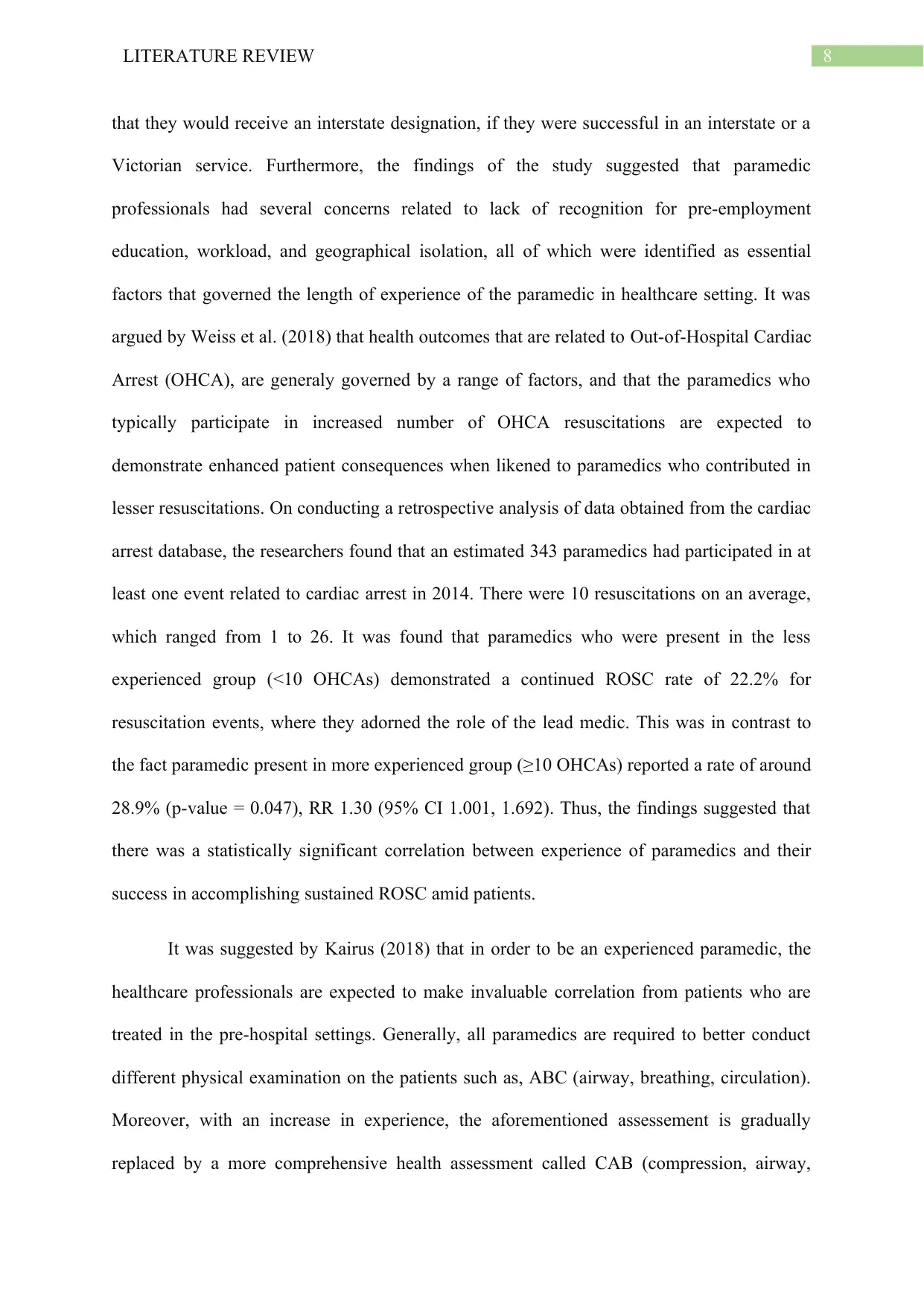
8LITERATURE REVIEW
that they would receive an interstate designation, if they were successful in an interstate or a
Victorian service. Furthermore, the findings of the study suggested that paramedic
professionals had several concerns related to lack of recognition for pre-employment
education, workload, and geographical isolation, all of which were identified as essential
factors that governed the length of experience of the paramedic in healthcare setting. It was
argued by Weiss et al. (2018) that health outcomes that are related to Out-of-Hospital Cardiac
Arrest (OHCA), are generaly governed by a range of factors, and that the paramedics who
typically participate in increased number of OHCA resuscitations are expected to
demonstrate enhanced patient consequences when likened to paramedics who contributed in
lesser resuscitations. On conducting a retrospective analysis of data obtained from the cardiac
arrest database, the researchers found that an estimated 343 paramedics had participated in at
least one event related to cardiac arrest in 2014. There were 10 resuscitations on an average,
which ranged from 1 to 26. It was found that paramedics who were present in the less
experienced group (<10 OHCAs) demonstrated a continued ROSC rate of 22.2% for
resuscitation events, where they adorned the role of the lead medic. This was in contrast to
the fact paramedic present in more experienced group (≥10 OHCAs) reported a rate of around
28.9% (p-value = 0.047), RR 1.30 (95% CI 1.001, 1.692). Thus, the findings suggested that
there was a statistically significant correlation between experience of paramedics and their
success in accomplishing sustained ROSC amid patients.
It was suggested by Kairus (2018) that in order to be an experienced paramedic, the
healthcare professionals are expected to make invaluable correlation from patients who are
treated in the pre-hospital settings. Generally, all paramedics are required to better conduct
different physical examination on the patients such as, ABC (airway, breathing, circulation).
Moreover, with an increase in experience, the aforementioned assessement is gradually
replaced by a more comprehensive health assessment called CAB (compression, airway,
that they would receive an interstate designation, if they were successful in an interstate or a
Victorian service. Furthermore, the findings of the study suggested that paramedic
professionals had several concerns related to lack of recognition for pre-employment
education, workload, and geographical isolation, all of which were identified as essential
factors that governed the length of experience of the paramedic in healthcare setting. It was
argued by Weiss et al. (2018) that health outcomes that are related to Out-of-Hospital Cardiac
Arrest (OHCA), are generaly governed by a range of factors, and that the paramedics who
typically participate in increased number of OHCA resuscitations are expected to
demonstrate enhanced patient consequences when likened to paramedics who contributed in
lesser resuscitations. On conducting a retrospective analysis of data obtained from the cardiac
arrest database, the researchers found that an estimated 343 paramedics had participated in at
least one event related to cardiac arrest in 2014. There were 10 resuscitations on an average,
which ranged from 1 to 26. It was found that paramedics who were present in the less
experienced group (<10 OHCAs) demonstrated a continued ROSC rate of 22.2% for
resuscitation events, where they adorned the role of the lead medic. This was in contrast to
the fact paramedic present in more experienced group (≥10 OHCAs) reported a rate of around
28.9% (p-value = 0.047), RR 1.30 (95% CI 1.001, 1.692). Thus, the findings suggested that
there was a statistically significant correlation between experience of paramedics and their
success in accomplishing sustained ROSC amid patients.
It was suggested by Kairus (2018) that in order to be an experienced paramedic, the
healthcare professionals are expected to make invaluable correlation from patients who are
treated in the pre-hospital settings. Generally, all paramedics are required to better conduct
different physical examination on the patients such as, ABC (airway, breathing, circulation).
Moreover, with an increase in experience, the aforementioned assessement is gradually
replaced by a more comprehensive health assessment called CAB (compression, airway,
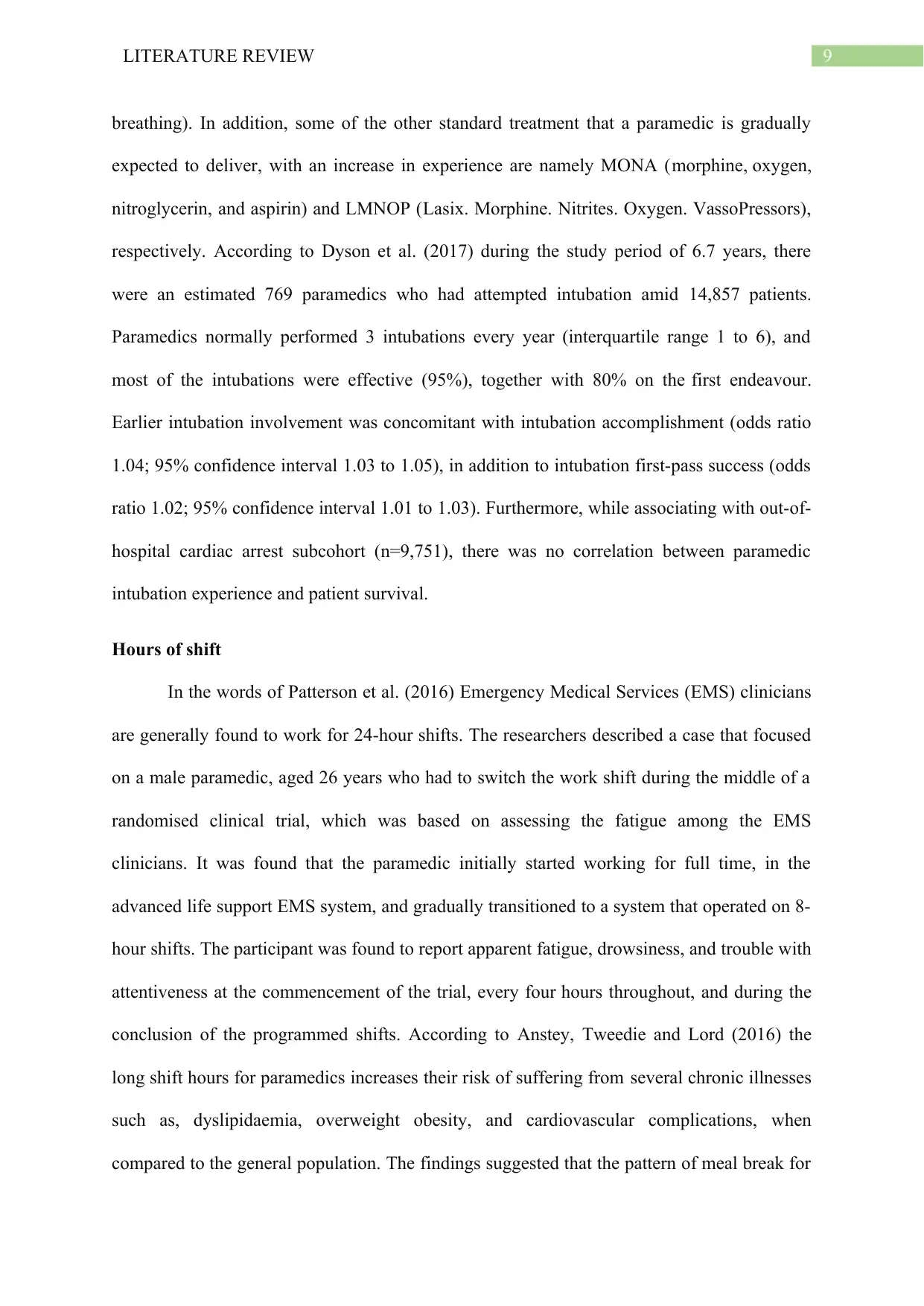
9LITERATURE REVIEW
breathing). In addition, some of the other standard treatment that a paramedic is gradually
expected to deliver, with an increase in experience are namely MONA (morphine, oxygen,
nitroglycerin, and aspirin) and LMNOP (Lasix. Morphine. Nitrites. Oxygen. VassoPressors),
respectively. According to Dyson et al. (2017) during the study period of 6.7 years, there
were an estimated 769 paramedics who had attempted intubation amid 14,857 patients.
Paramedics normally performed 3 intubations every year (interquartile range 1 to 6), and
most of the intubations were effective (95%), together with 80% on the first endeavour.
Earlier intubation involvement was concomitant with intubation accomplishment (odds ratio
1.04; 95% confidence interval 1.03 to 1.05), in addition to intubation first-pass success (odds
ratio 1.02; 95% confidence interval 1.01 to 1.03). Furthermore, while associating with out-of-
hospital cardiac arrest subcohort (n=9,751), there was no correlation between paramedic
intubation experience and patient survival.
Hours of shift
In the words of Patterson et al. (2016) Emergency Medical Services (EMS) clinicians
are generally found to work for 24-hour shifts. The researchers described a case that focused
on a male paramedic, aged 26 years who had to switch the work shift during the middle of a
randomised clinical trial, which was based on assessing the fatigue among the EMS
clinicians. It was found that the paramedic initially started working for full time, in the
advanced life support EMS system, and gradually transitioned to a system that operated on 8-
hour shifts. The participant was found to report apparent fatigue, drowsiness, and trouble with
attentiveness at the commencement of the trial, every four hours throughout, and during the
conclusion of the programmed shifts. According to Anstey, Tweedie and Lord (2016) the
long shift hours for paramedics increases their risk of suffering from several chronic illnesses
such as, dyslipidaemia, overweight obesity, and cardiovascular complications, when
compared to the general population. The findings suggested that the pattern of meal break for
breathing). In addition, some of the other standard treatment that a paramedic is gradually
expected to deliver, with an increase in experience are namely MONA (morphine, oxygen,
nitroglycerin, and aspirin) and LMNOP (Lasix. Morphine. Nitrites. Oxygen. VassoPressors),
respectively. According to Dyson et al. (2017) during the study period of 6.7 years, there
were an estimated 769 paramedics who had attempted intubation amid 14,857 patients.
Paramedics normally performed 3 intubations every year (interquartile range 1 to 6), and
most of the intubations were effective (95%), together with 80% on the first endeavour.
Earlier intubation involvement was concomitant with intubation accomplishment (odds ratio
1.04; 95% confidence interval 1.03 to 1.05), in addition to intubation first-pass success (odds
ratio 1.02; 95% confidence interval 1.01 to 1.03). Furthermore, while associating with out-of-
hospital cardiac arrest subcohort (n=9,751), there was no correlation between paramedic
intubation experience and patient survival.
Hours of shift
In the words of Patterson et al. (2016) Emergency Medical Services (EMS) clinicians
are generally found to work for 24-hour shifts. The researchers described a case that focused
on a male paramedic, aged 26 years who had to switch the work shift during the middle of a
randomised clinical trial, which was based on assessing the fatigue among the EMS
clinicians. It was found that the paramedic initially started working for full time, in the
advanced life support EMS system, and gradually transitioned to a system that operated on 8-
hour shifts. The participant was found to report apparent fatigue, drowsiness, and trouble with
attentiveness at the commencement of the trial, every four hours throughout, and during the
conclusion of the programmed shifts. According to Anstey, Tweedie and Lord (2016) the
long shift hours for paramedics increases their risk of suffering from several chronic illnesses
such as, dyslipidaemia, overweight obesity, and cardiovascular complications, when
compared to the general population. The findings suggested that the pattern of meal break for
Secure Best Marks with AI Grader
Need help grading? Try our AI Grader for instant feedback on your assignments.
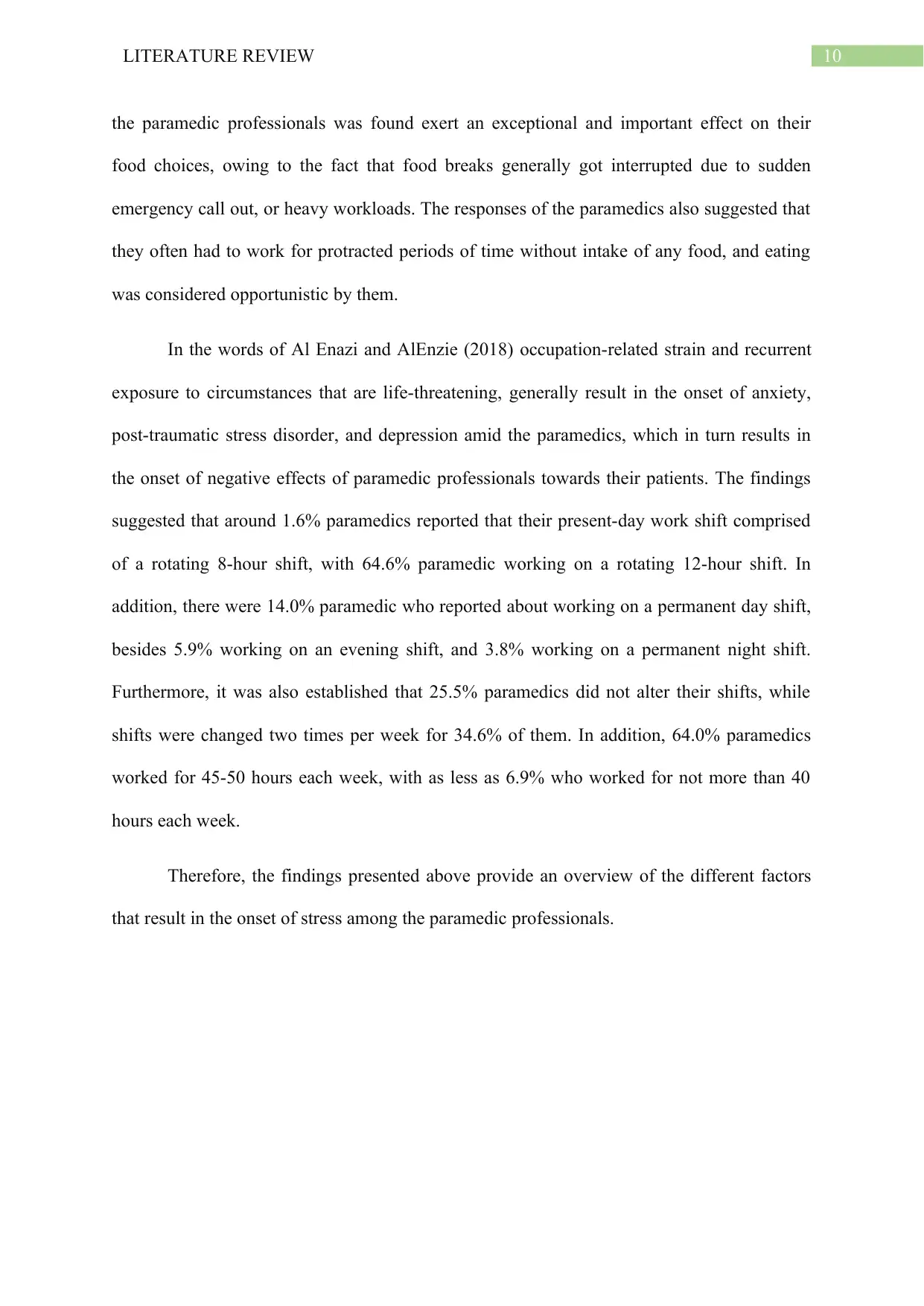
10LITERATURE REVIEW
the paramedic professionals was found exert an exceptional and important effect on their
food choices, owing to the fact that food breaks generally got interrupted due to sudden
emergency call out, or heavy workloads. The responses of the paramedics also suggested that
they often had to work for protracted periods of time without intake of any food, and eating
was considered opportunistic by them.
In the words of Al Enazi and AlEnzie (2018) occupation-related strain and recurrent
exposure to circumstances that are life-threatening, generally result in the onset of anxiety,
post-traumatic stress disorder, and depression amid the paramedics, which in turn results in
the onset of negative effects of paramedic professionals towards their patients. The findings
suggested that around 1.6% paramedics reported that their present-day work shift comprised
of a rotating 8-hour shift, with 64.6% paramedic working on a rotating 12-hour shift. In
addition, there were 14.0% paramedic who reported about working on a permanent day shift,
besides 5.9% working on an evening shift, and 3.8% working on a permanent night shift.
Furthermore, it was also established that 25.5% paramedics did not alter their shifts, while
shifts were changed two times per week for 34.6% of them. In addition, 64.0% paramedics
worked for 45-50 hours each week, with as less as 6.9% who worked for not more than 40
hours each week.
Therefore, the findings presented above provide an overview of the different factors
that result in the onset of stress among the paramedic professionals.
the paramedic professionals was found exert an exceptional and important effect on their
food choices, owing to the fact that food breaks generally got interrupted due to sudden
emergency call out, or heavy workloads. The responses of the paramedics also suggested that
they often had to work for protracted periods of time without intake of any food, and eating
was considered opportunistic by them.
In the words of Al Enazi and AlEnzie (2018) occupation-related strain and recurrent
exposure to circumstances that are life-threatening, generally result in the onset of anxiety,
post-traumatic stress disorder, and depression amid the paramedics, which in turn results in
the onset of negative effects of paramedic professionals towards their patients. The findings
suggested that around 1.6% paramedics reported that their present-day work shift comprised
of a rotating 8-hour shift, with 64.6% paramedic working on a rotating 12-hour shift. In
addition, there were 14.0% paramedic who reported about working on a permanent day shift,
besides 5.9% working on an evening shift, and 3.8% working on a permanent night shift.
Furthermore, it was also established that 25.5% paramedics did not alter their shifts, while
shifts were changed two times per week for 34.6% of them. In addition, 64.0% paramedics
worked for 45-50 hours each week, with as less as 6.9% who worked for not more than 40
hours each week.
Therefore, the findings presented above provide an overview of the different factors
that result in the onset of stress among the paramedic professionals.
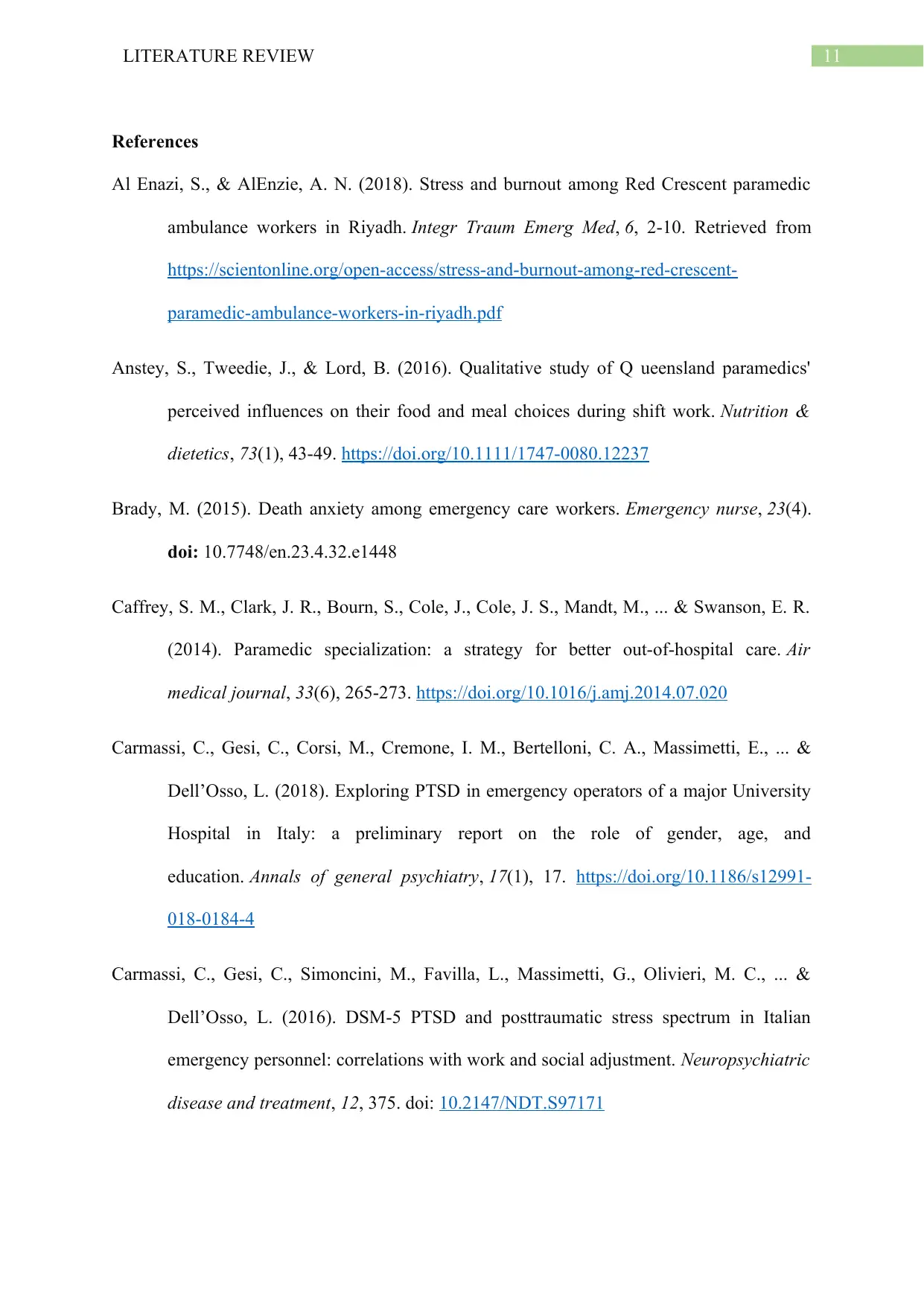
11LITERATURE REVIEW
References
Al Enazi, S., & AlEnzie, A. N. (2018). Stress and burnout among Red Crescent paramedic
ambulance workers in Riyadh. Integr Traum Emerg Med, 6, 2-10. Retrieved from
https://scientonline.org/open-access/stress-and-burnout-among-red-crescent-
paramedic-ambulance-workers-in-riyadh.pdf
Anstey, S., Tweedie, J., & Lord, B. (2016). Qualitative study of Q ueensland paramedics'
perceived influences on their food and meal choices during shift work. Nutrition &
dietetics, 73(1), 43-49. https://doi.org/10.1111/1747-0080.12237
Brady, M. (2015). Death anxiety among emergency care workers. Emergency nurse, 23(4).
doi: 10.7748/en.23.4.32.e1448
Caffrey, S. M., Clark, J. R., Bourn, S., Cole, J., Cole, J. S., Mandt, M., ... & Swanson, E. R.
(2014). Paramedic specialization: a strategy for better out-of-hospital care. Air
medical journal, 33(6), 265-273. https://doi.org/10.1016/j.amj.2014.07.020
Carmassi, C., Gesi, C., Corsi, M., Cremone, I. M., Bertelloni, C. A., Massimetti, E., ... &
Dell’Osso, L. (2018). Exploring PTSD in emergency operators of a major University
Hospital in Italy: a preliminary report on the role of gender, age, and
education. Annals of general psychiatry, 17(1), 17. https://doi.org/10.1186/s12991-
018-0184-4
Carmassi, C., Gesi, C., Simoncini, M., Favilla, L., Massimetti, G., Olivieri, M. C., ... &
Dell’Osso, L. (2016). DSM-5 PTSD and posttraumatic stress spectrum in Italian
emergency personnel: correlations with work and social adjustment. Neuropsychiatric
disease and treatment, 12, 375. doi: 10.2147/NDT.S97171
References
Al Enazi, S., & AlEnzie, A. N. (2018). Stress and burnout among Red Crescent paramedic
ambulance workers in Riyadh. Integr Traum Emerg Med, 6, 2-10. Retrieved from
https://scientonline.org/open-access/stress-and-burnout-among-red-crescent-
paramedic-ambulance-workers-in-riyadh.pdf
Anstey, S., Tweedie, J., & Lord, B. (2016). Qualitative study of Q ueensland paramedics'
perceived influences on their food and meal choices during shift work. Nutrition &
dietetics, 73(1), 43-49. https://doi.org/10.1111/1747-0080.12237
Brady, M. (2015). Death anxiety among emergency care workers. Emergency nurse, 23(4).
doi: 10.7748/en.23.4.32.e1448
Caffrey, S. M., Clark, J. R., Bourn, S., Cole, J., Cole, J. S., Mandt, M., ... & Swanson, E. R.
(2014). Paramedic specialization: a strategy for better out-of-hospital care. Air
medical journal, 33(6), 265-273. https://doi.org/10.1016/j.amj.2014.07.020
Carmassi, C., Gesi, C., Corsi, M., Cremone, I. M., Bertelloni, C. A., Massimetti, E., ... &
Dell’Osso, L. (2018). Exploring PTSD in emergency operators of a major University
Hospital in Italy: a preliminary report on the role of gender, age, and
education. Annals of general psychiatry, 17(1), 17. https://doi.org/10.1186/s12991-
018-0184-4
Carmassi, C., Gesi, C., Simoncini, M., Favilla, L., Massimetti, G., Olivieri, M. C., ... &
Dell’Osso, L. (2016). DSM-5 PTSD and posttraumatic stress spectrum in Italian
emergency personnel: correlations with work and social adjustment. Neuropsychiatric
disease and treatment, 12, 375. doi: 10.2147/NDT.S97171
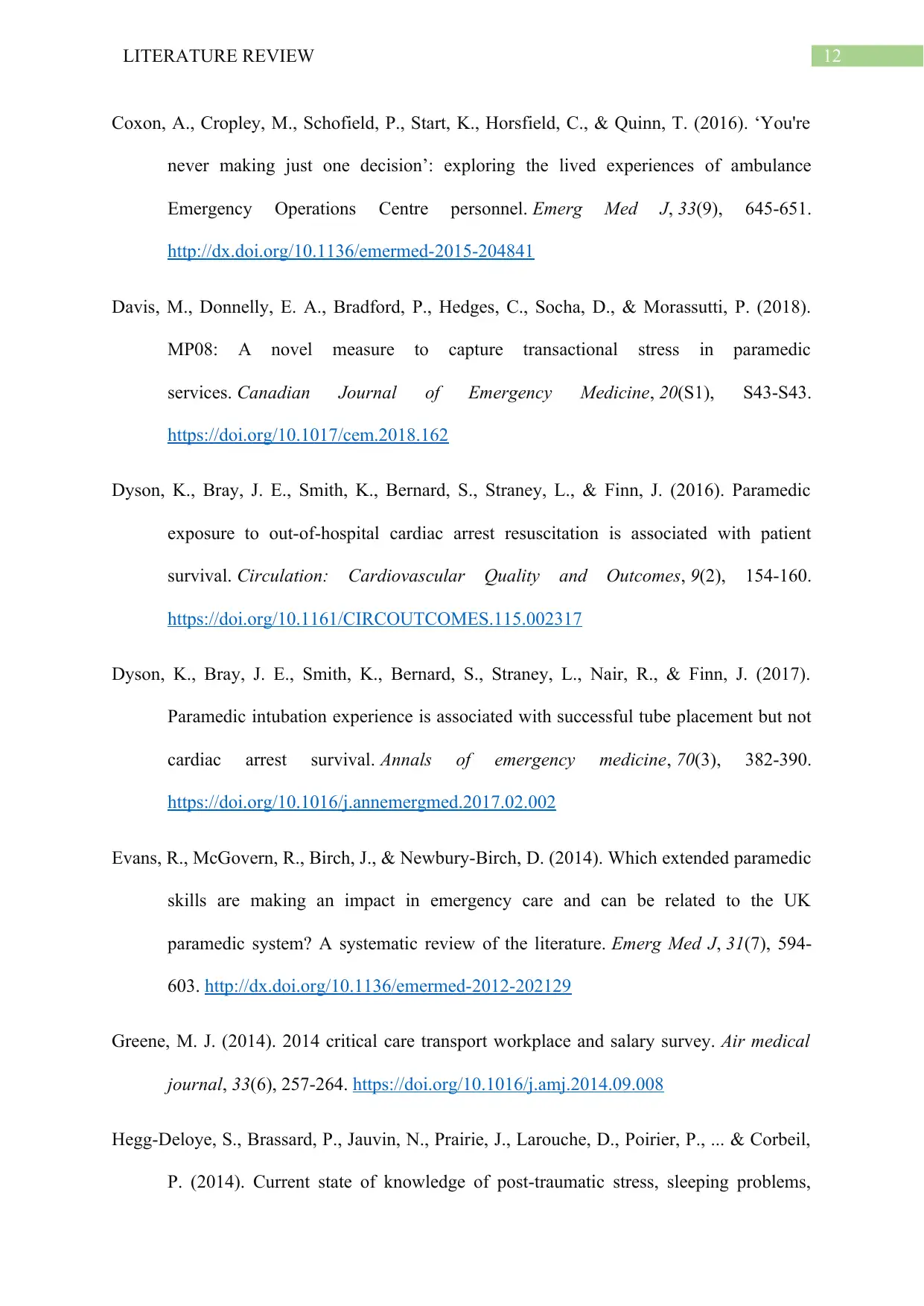
12LITERATURE REVIEW
Coxon, A., Cropley, M., Schofield, P., Start, K., Horsfield, C., & Quinn, T. (2016). ‘You're
never making just one decision’: exploring the lived experiences of ambulance
Emergency Operations Centre personnel. Emerg Med J, 33(9), 645-651.
http://dx.doi.org/10.1136/emermed-2015-204841
Davis, M., Donnelly, E. A., Bradford, P., Hedges, C., Socha, D., & Morassutti, P. (2018).
MP08: A novel measure to capture transactional stress in paramedic
services. Canadian Journal of Emergency Medicine, 20(S1), S43-S43.
https://doi.org/10.1017/cem.2018.162
Dyson, K., Bray, J. E., Smith, K., Bernard, S., Straney, L., & Finn, J. (2016). Paramedic
exposure to out-of-hospital cardiac arrest resuscitation is associated with patient
survival. Circulation: Cardiovascular Quality and Outcomes, 9(2), 154-160.
https://doi.org/10.1161/CIRCOUTCOMES.115.002317
Dyson, K., Bray, J. E., Smith, K., Bernard, S., Straney, L., Nair, R., & Finn, J. (2017).
Paramedic intubation experience is associated with successful tube placement but not
cardiac arrest survival. Annals of emergency medicine, 70(3), 382-390.
https://doi.org/10.1016/j.annemergmed.2017.02.002
Evans, R., McGovern, R., Birch, J., & Newbury-Birch, D. (2014). Which extended paramedic
skills are making an impact in emergency care and can be related to the UK
paramedic system? A systematic review of the literature. Emerg Med J, 31(7), 594-
603. http://dx.doi.org/10.1136/emermed-2012-202129
Greene, M. J. (2014). 2014 critical care transport workplace and salary survey. Air medical
journal, 33(6), 257-264. https://doi.org/10.1016/j.amj.2014.09.008
Hegg-Deloye, S., Brassard, P., Jauvin, N., Prairie, J., Larouche, D., Poirier, P., ... & Corbeil,
P. (2014). Current state of knowledge of post-traumatic stress, sleeping problems,
Coxon, A., Cropley, M., Schofield, P., Start, K., Horsfield, C., & Quinn, T. (2016). ‘You're
never making just one decision’: exploring the lived experiences of ambulance
Emergency Operations Centre personnel. Emerg Med J, 33(9), 645-651.
http://dx.doi.org/10.1136/emermed-2015-204841
Davis, M., Donnelly, E. A., Bradford, P., Hedges, C., Socha, D., & Morassutti, P. (2018).
MP08: A novel measure to capture transactional stress in paramedic
services. Canadian Journal of Emergency Medicine, 20(S1), S43-S43.
https://doi.org/10.1017/cem.2018.162
Dyson, K., Bray, J. E., Smith, K., Bernard, S., Straney, L., & Finn, J. (2016). Paramedic
exposure to out-of-hospital cardiac arrest resuscitation is associated with patient
survival. Circulation: Cardiovascular Quality and Outcomes, 9(2), 154-160.
https://doi.org/10.1161/CIRCOUTCOMES.115.002317
Dyson, K., Bray, J. E., Smith, K., Bernard, S., Straney, L., Nair, R., & Finn, J. (2017).
Paramedic intubation experience is associated with successful tube placement but not
cardiac arrest survival. Annals of emergency medicine, 70(3), 382-390.
https://doi.org/10.1016/j.annemergmed.2017.02.002
Evans, R., McGovern, R., Birch, J., & Newbury-Birch, D. (2014). Which extended paramedic
skills are making an impact in emergency care and can be related to the UK
paramedic system? A systematic review of the literature. Emerg Med J, 31(7), 594-
603. http://dx.doi.org/10.1136/emermed-2012-202129
Greene, M. J. (2014). 2014 critical care transport workplace and salary survey. Air medical
journal, 33(6), 257-264. https://doi.org/10.1016/j.amj.2014.09.008
Hegg-Deloye, S., Brassard, P., Jauvin, N., Prairie, J., Larouche, D., Poirier, P., ... & Corbeil,
P. (2014). Current state of knowledge of post-traumatic stress, sleeping problems,
Paraphrase This Document
Need a fresh take? Get an instant paraphrase of this document with our AI Paraphraser
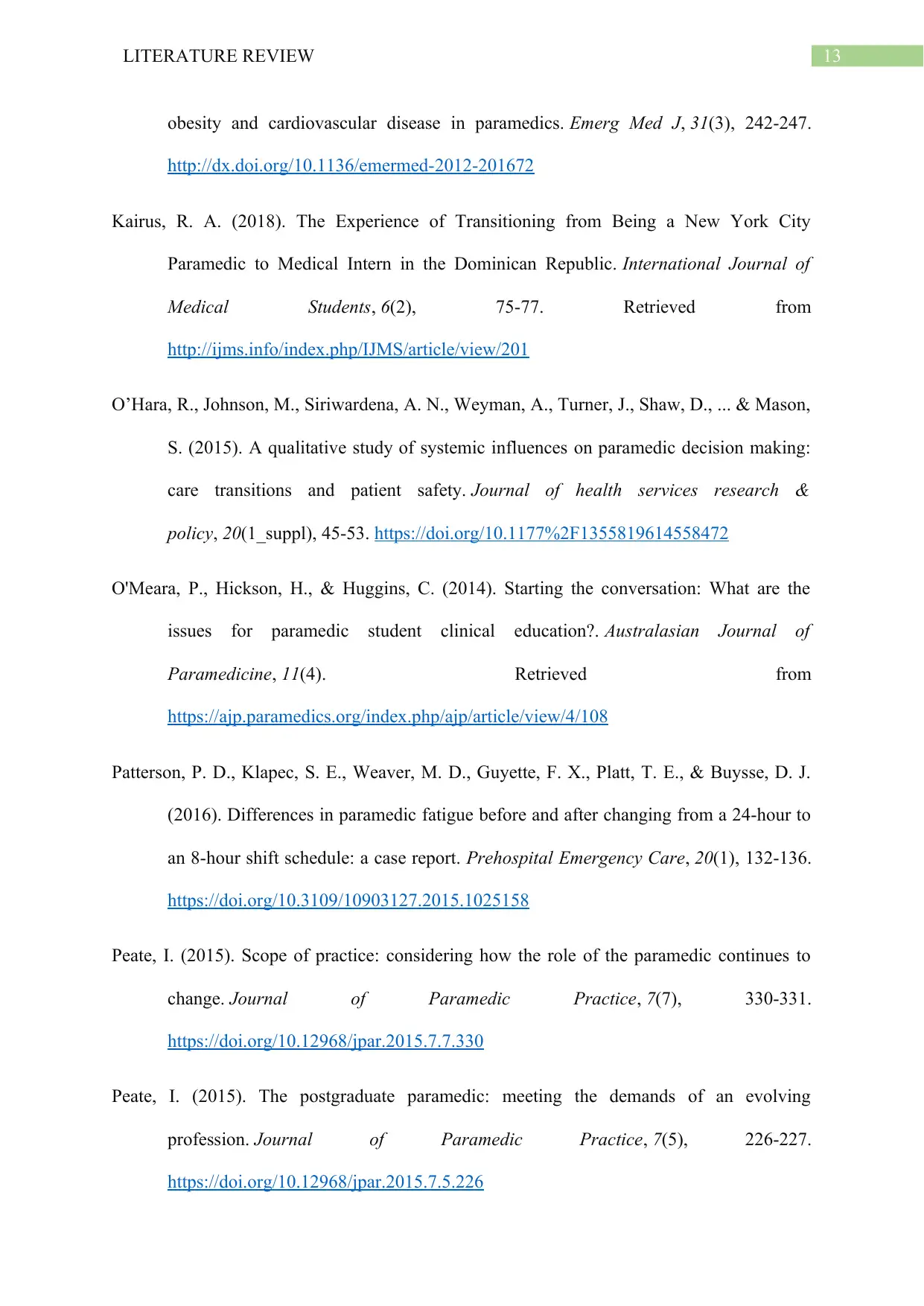
13LITERATURE REVIEW
obesity and cardiovascular disease in paramedics. Emerg Med J, 31(3), 242-247.
http://dx.doi.org/10.1136/emermed-2012-201672
Kairus, R. A. (2018). The Experience of Transitioning from Being a New York City
Paramedic to Medical Intern in the Dominican Republic. International Journal of
Medical Students, 6(2), 75-77. Retrieved from
http://ijms.info/index.php/IJMS/article/view/201
O’Hara, R., Johnson, M., Siriwardena, A. N., Weyman, A., Turner, J., Shaw, D., ... & Mason,
S. (2015). A qualitative study of systemic influences on paramedic decision making:
care transitions and patient safety. Journal of health services research &
policy, 20(1_suppl), 45-53. https://doi.org/10.1177%2F1355819614558472
O'Meara, P., Hickson, H., & Huggins, C. (2014). Starting the conversation: What are the
issues for paramedic student clinical education?. Australasian Journal of
Paramedicine, 11(4). Retrieved from
https://ajp.paramedics.org/index.php/ajp/article/view/4/108
Patterson, P. D., Klapec, S. E., Weaver, M. D., Guyette, F. X., Platt, T. E., & Buysse, D. J.
(2016). Differences in paramedic fatigue before and after changing from a 24-hour to
an 8-hour shift schedule: a case report. Prehospital Emergency Care, 20(1), 132-136.
https://doi.org/10.3109/10903127.2015.1025158
Peate, I. (2015). Scope of practice: considering how the role of the paramedic continues to
change. Journal of Paramedic Practice, 7(7), 330-331.
https://doi.org/10.12968/jpar.2015.7.7.330
Peate, I. (2015). The postgraduate paramedic: meeting the demands of an evolving
profession. Journal of Paramedic Practice, 7(5), 226-227.
https://doi.org/10.12968/jpar.2015.7.5.226
obesity and cardiovascular disease in paramedics. Emerg Med J, 31(3), 242-247.
http://dx.doi.org/10.1136/emermed-2012-201672
Kairus, R. A. (2018). The Experience of Transitioning from Being a New York City
Paramedic to Medical Intern in the Dominican Republic. International Journal of
Medical Students, 6(2), 75-77. Retrieved from
http://ijms.info/index.php/IJMS/article/view/201
O’Hara, R., Johnson, M., Siriwardena, A. N., Weyman, A., Turner, J., Shaw, D., ... & Mason,
S. (2015). A qualitative study of systemic influences on paramedic decision making:
care transitions and patient safety. Journal of health services research &
policy, 20(1_suppl), 45-53. https://doi.org/10.1177%2F1355819614558472
O'Meara, P., Hickson, H., & Huggins, C. (2014). Starting the conversation: What are the
issues for paramedic student clinical education?. Australasian Journal of
Paramedicine, 11(4). Retrieved from
https://ajp.paramedics.org/index.php/ajp/article/view/4/108
Patterson, P. D., Klapec, S. E., Weaver, M. D., Guyette, F. X., Platt, T. E., & Buysse, D. J.
(2016). Differences in paramedic fatigue before and after changing from a 24-hour to
an 8-hour shift schedule: a case report. Prehospital Emergency Care, 20(1), 132-136.
https://doi.org/10.3109/10903127.2015.1025158
Peate, I. (2015). Scope of practice: considering how the role of the paramedic continues to
change. Journal of Paramedic Practice, 7(7), 330-331.
https://doi.org/10.12968/jpar.2015.7.7.330
Peate, I. (2015). The postgraduate paramedic: meeting the demands of an evolving
profession. Journal of Paramedic Practice, 7(5), 226-227.
https://doi.org/10.12968/jpar.2015.7.5.226
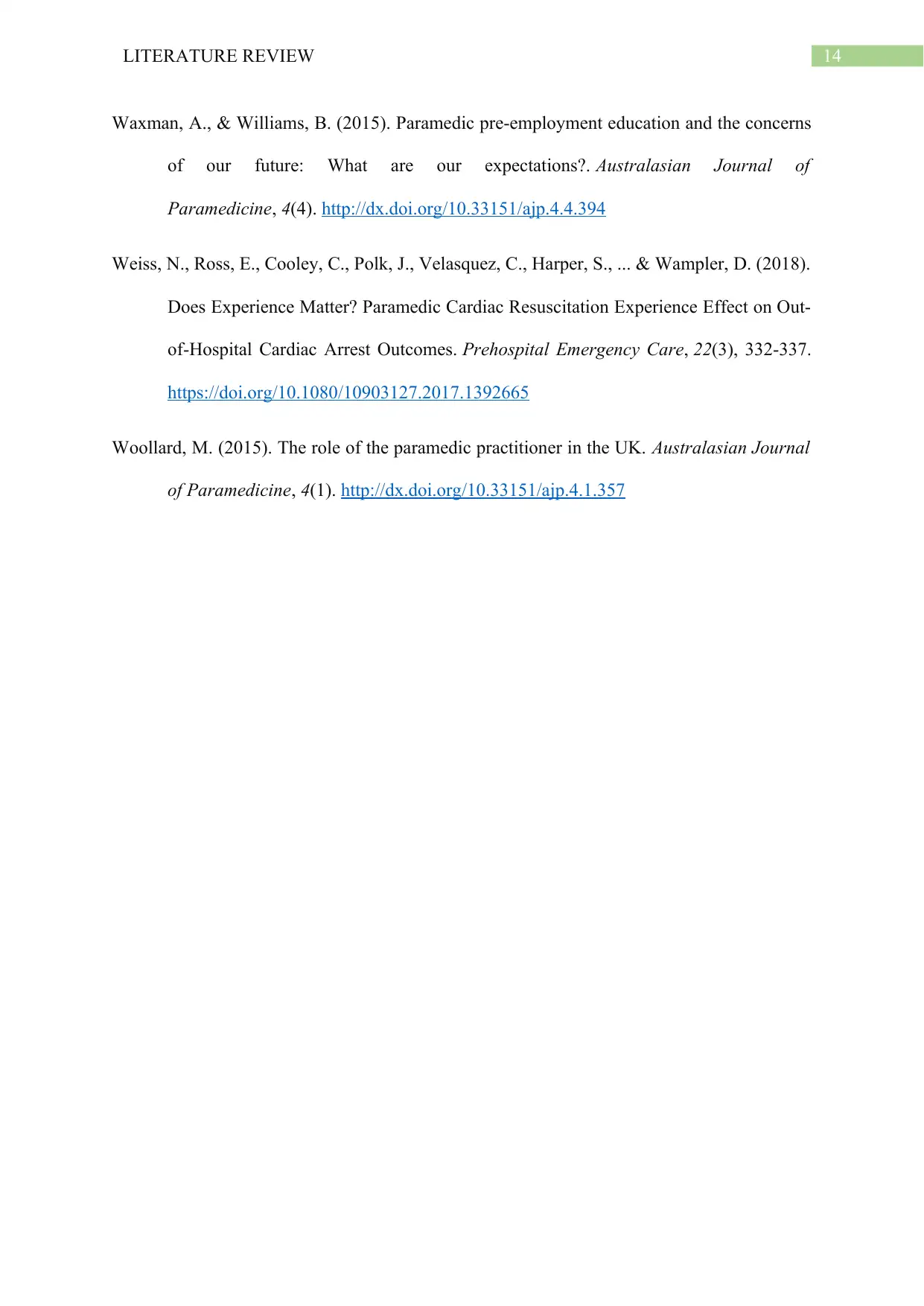
14LITERATURE REVIEW
Waxman, A., & Williams, B. (2015). Paramedic pre-employment education and the concerns
of our future: What are our expectations?. Australasian Journal of
Paramedicine, 4(4). http://dx.doi.org/10.33151/ajp.4.4.394
Weiss, N., Ross, E., Cooley, C., Polk, J., Velasquez, C., Harper, S., ... & Wampler, D. (2018).
Does Experience Matter? Paramedic Cardiac Resuscitation Experience Effect on Out-
of-Hospital Cardiac Arrest Outcomes. Prehospital Emergency Care, 22(3), 332-337.
https://doi.org/10.1080/10903127.2017.1392665
Woollard, M. (2015). The role of the paramedic practitioner in the UK. Australasian Journal
of Paramedicine, 4(1). http://dx.doi.org/10.33151/ajp.4.1.357
Waxman, A., & Williams, B. (2015). Paramedic pre-employment education and the concerns
of our future: What are our expectations?. Australasian Journal of
Paramedicine, 4(4). http://dx.doi.org/10.33151/ajp.4.4.394
Weiss, N., Ross, E., Cooley, C., Polk, J., Velasquez, C., Harper, S., ... & Wampler, D. (2018).
Does Experience Matter? Paramedic Cardiac Resuscitation Experience Effect on Out-
of-Hospital Cardiac Arrest Outcomes. Prehospital Emergency Care, 22(3), 332-337.
https://doi.org/10.1080/10903127.2017.1392665
Woollard, M. (2015). The role of the paramedic practitioner in the UK. Australasian Journal
of Paramedicine, 4(1). http://dx.doi.org/10.33151/ajp.4.1.357
1 out of 15
Related Documents
Your All-in-One AI-Powered Toolkit for Academic Success.
+13062052269
info@desklib.com
Available 24*7 on WhatsApp / Email
![[object Object]](/_next/static/media/star-bottom.7253800d.svg)
Unlock your academic potential
© 2024 | Zucol Services PVT LTD | All rights reserved.





